I’m 40, I’m out of shape and I want to become a racing driver. One of these things isn’t particularly compatible with the other two.
I’m by no means unique. Most racing drivers are amateurs who take to the track later in life and the law of averages would suggest that most of them aren’t especially fit. And fitness matters in racing.
Formula One drivers are true athletes. They have to be. The G-forces, the heat, the concentration, the strategising – it’s like running a marathon while sitting a maths exam in a sauna with Tyson Fury taking his best shots. For two hours. And after all that, they hop out of the car looking fresh as a daisy and spend the rest of the day doing interviews, debriefs and sponsor events.

Amateur drivers don’t have to operate at that level, though you still have to be fearsomely fit to survive at the top levels of amateur racing, such as LMP2 and GT3. Even if you’re just tootling around at the back of the field in a minor club race, being fit still helps. Because you simply won’t be capable of driving quickly if you’re a knackered, sweaty, huffing-and-puffing wreck after two laps.
Put simply, the fitter you are, the faster you’ll be. Which puts me and every other out of shape, middle-aged bloke at an immediate disadvantage. And the situation will only get worse, unless I get off my problematically comfortable sofa and do something about it.
I could just start running and lifting weights, which would undoubtedly help. But racing puts specific strains on the body and it’s helpful to have a more balanced, holistic regime. And what level of fitness am I shooting for? More to the point, what level of fitness am I starting from?
I decided professional help was needed, ideally from people who know exactly what demands racing places on the body. So I turned to Porsche.
Porsche deals with every type of racing driver. There are the seasoned factory pros in the 963 Le Mans Hypercars, ambitious youngsters in the 911 Carrera Cup and middle-aged rookies in the Cayman Sprint Challenge. Porsche really cares about the fitness of all its drivers, and that’s where the Porsche Human Performance Centre (HPC) comes in.
Based at the Silverstone Porsche Experience Centre, the HPC has a team of motorsport fitness specialists with the ability to train a driver up to near-F1 levels. They don’t just work with racing drivers, either. The HPC sees all sorts of professional athletes including cyclists and runners pass through its doors, as well as people who just want to get a bit fitter. So they shouldn’t have any trouble whipping me into shape.
The first stage in the process is a full fitness assessment. On the appointed day, I arrive at Silverstone fully expecting that I’ll be half-dead by lunchtime. It’s not like I do no exercise at all. I walk a lot and do some weights every day. But I know I’ll be pushed harder than I would ever push myself.
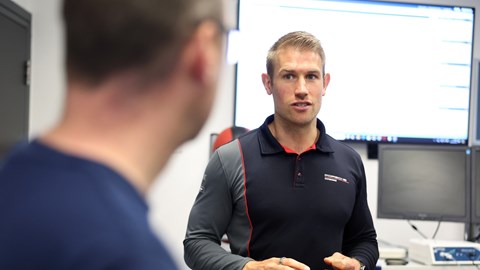
I’m met by Porsche PR James, who very generously arranged the day and introduces me to Jack Wilson, Porsche’s sport and exercise scientist and himself a man of fearsome fitness. Jack has been working at the HPC for 10 years; he and his colleague Beth Cate will be my assessors, instructors, cheer leaders and shoulders to cry on – if it comes to that.
The gym is a surprisingly small room but it’s packed with top-of-the-line kit. There’s a pretty serious-looking exercise bike at one end, a huge rack of weights at the other. A Batak board hangs from the wall, behind a door there’s a heat chamber that’s used to train in the kind of temperatures drivers experience during a race.
We start with the basics – my height is measured (five-foot-nine-and-a-half) and I stand on a machine that determines my body composition. Two handles fire electric pulses around the body, travelling at different speeds through bone, muscle and fat. Those speeds are used to calculate the proportions of those substances.
Next, we move on to the first real test – the VO2 max test. I hop aboard the exercise bike and a mask is attached to my face. The test determines how much oxygen the body can absorb, the result given in units of millilitres of oxygen per minute per kilo of body mass. It’s roughly analogous to a car’s MPG.
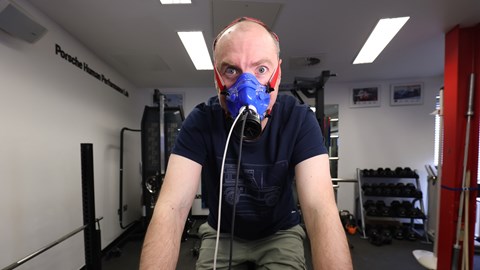
I ride up a simulated slope that increases in gradient every minute – in reality, the bike is giving more resistance – and I have to achieve a consistent pace. 70rpm turns out to be the top end of what’s comfortable and I watch the rev counter like a hawk as the resistance grows and grows. 65rpm I’m okay with, anything below that and I dig deeper. The resistance increases and I push and push, Beth’s encouragement carrying me along. At the seven-minute mark, I reach 225% resistance. I push harder than I’ve ever pushed before but my breath starts burning so it’s time to call it quits. Much to my amazement, I don’t collapse off the bike.
Then it’s on to the Batak board. It’s a frame holding 12 buttons that light up in a random sequence. It’s a test of reaction time and peripheral vision, the idea is to hit the lit buttons as quickly as possible. My target is 80 in one minute; F1 drivers can achieve 120, possibly more. It’s a fun exercise yet deeply frustrating. I struggle to see the top corners – I’m blaming the frames of my glasses – but I manage to breach the one per second barrier.
The next couple of hours pass in a bit of blur. After a warm-up session that acts on muscles I didn’t know I have, my strength, endurance and explosive force are tested in many different ways. I jump, I pull on a fixed weights bar with all my might, I plank, press-up and pull-up, squeeze and push against devices that measure grip and neck strength.
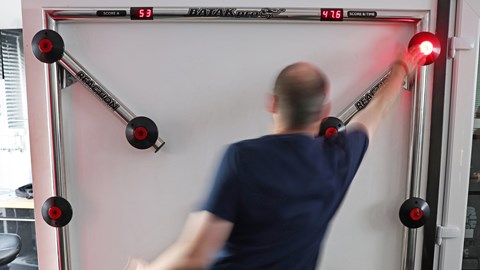
Throughout, Jack and Beth explain everything clearly, answer stupid questions patiently, affirm when I’m doing well, encourage me when I’m not. I really can’t say strongly enough how fantastic they both are during the day.
We finally reach the end of the assessment and, to my amazement, I’m not dead. Indeed, I actually enjoyed myself. Over an excellent lunch, Jack talks me through the initial results and, well…
I missed the target on every test. However, that target was what they would expect of a driver fit enough to race in the Sprint Challenge, the benchmark I specified. But for someone like me, who doesn’t do any training and is, it turns out, getting on for two stone overweight, it’s not a disaster. But there is a lot of work to do.
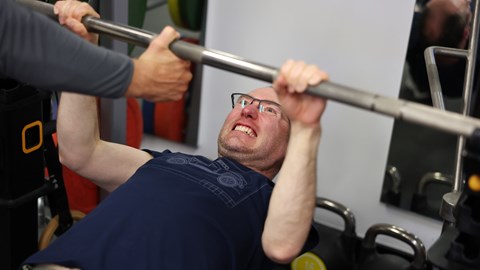
Jack shows me a matrix with each exercise and a scale of one to ten. Each level on the scale gives the time you should be able to hold a position for, the weight you should be able to lift, the force you should be able to exert. A Sprint Challenge driver should be at level four or five across the board. For most of the exercises, I’m below level one. Though I do reach level five on the back extension hold – a cantilevered, armless plank.
A few days later, the full report arrives. It makes for pretty grim reading. More importantly, though, it includes a work-out regime. According to Jack, if I stick to it for six months of hard work, I should be able reach the level of fitness I’m aiming for. A level that should allow me to jump into pretty much any race car short of GT3 machinery and drive it to the best of my ability without being reduced to a knackered, sweaty, huffing-and-puffing wreck.
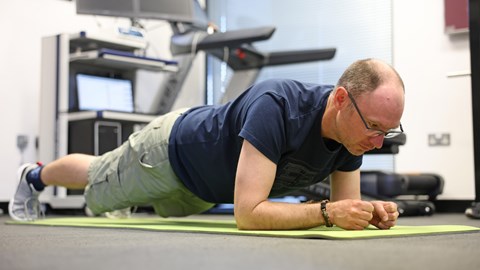
I have made my first tentative attempts at the regime, somewhat hampered by a lack of some of the necessary equipment, but I’m working on that. Hopefully I’ll see appreciable results within a few months and I’ll report back on my progress in due course, plus the other stages in the process of getting a racing license and taking to the track. Wish me luck.